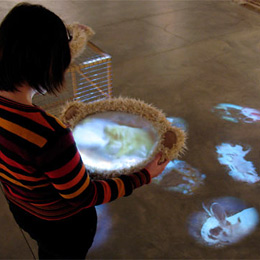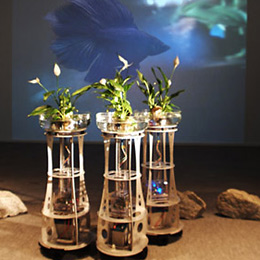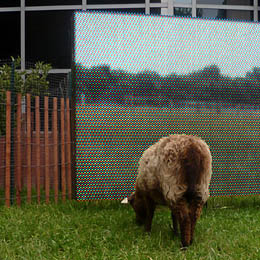SYLLABUS
Course
Description
Do we know our pets, our food animals
and zoo animals better now that we can monitor them remotely, at
any time we want? When the experience is enhanced with the availability
of internet-enabled devices, games and communication tools, will
we have closer relationships with them? This course is inspired
by telepresence robots, the proliferation of live animal webcams
and the increasing presence of animals in art - living, dead and
virtual. Together we will explore animal/human/machine relationships
through readings, discussions, screenings,
lectures, field trips and hands on art making. We will
make art for insects, learn to set up, monitor and activate internet-enabled
devices, and develop individual and group artwork inspired by the course
content.
Course Meeting Time and Locations
Mon/Wed, 6:55 - 9:40 Hopkins Hall 156.
Instructors
Amy
Youngs, Associate Professor of Art
email: youngs.6@osu.edu -
best way to contact me
ph: Art
Department (614) 292-5072 - a place to leave messages for me.
Office: Hopkins Hall, room 150. Mailbox: 258 Hopkins Hall
Jessica Ann, Graduate Teaching Assistant
email: jessicaann.info@gmail.com
Mailbox: 258 Hopkins Hall
Objectives
- To create art engaged with the presence, telepresence and representation
of animals.
- To gain a understanding of the theories and artistic strategies
used by artists working with machine/animal relationships
- Demonstrated abiliity to discuss, remix, and invent new
creative work inspired by the course topic.
- To professionally mount and exhibit a artwork
from this course in the end of the quarter Art & Technology Exhibition.
Requirements
Two completed art projects, participation in class activities and
discussions, research notebook, participation in the end of the
quarter Art and Technology exhibition, and regular attendance. An
average student can expect to work an average of 6 hours per week
on class work outside of class time.
Grading
20 points – Project 1 - Art designed for insects
20 points – Reflective note taking in Tumblr
blog and Sketchbook -
your observations, online and off, sketches, photos, maps, reflections, notes
and ideas connected to the topics in this course and your art projects.
20 points – Active participation in class activities and discussions,
as well as general class citizenship.
40 points – Final project - a significant, well-researched artwork
inspired by the Telepresent Animal course content. Must be submitted to the
Art and Tech juried show.
Critiques
Class critiques are very important and will be held at
the beginning of class on the due date of each project. If your assignment
is not complete for the critique your grade on that assignment will be
lowered by one full letter for each class day it is late. You are required
to attend critiques even if your work is not complete. Critiques are not
for my benefit; instead, they are the best method to learn about artmaking
- from a diversity of fellow artmakers.
Bibliography
There will be required and optional readings and screenings in this course.
The required portions will be available online, in our Carmen resources,
or in the library. Check
the schedule for details.
Inspirations/bibliography for this class include:
Aloi, Giovanni, Art & Animals, I.B. Tauris, London/New
York, 2012.
Ascott, Roy, Telematic Embrace, University of California Press,
Berkeley and Los Angeles, 2003.
Baker, Steve, Artist |Animal, University
of Minnesota Press, Minneapolis, 2013.
Baker, Steve, The
Postmodern Animal, Reaktion Books, 2000
Berger, John, About Looking, Pantheon Books, New
York, 1980. (Why Look at Animals? essay in particular)
Chalmers, Catherine American
Cockroach, Aperature 2005
Da Costa, Beatriz and Philip, Kavita, Tactical
Biopolitics, Mit Press 2008.
Gessert, George, Green
Light: Toward an Art of Evolution, MIT Press, 2010.
Goldberg, Ken, ed. The Robot in the Garden, MIT press, 2000.
Haraway, Donna J., When Species Meet, University
of Minnesota Press, 2008.
Kac, Eduardo, Telepresence & Bio Art, University of Michigan Press, Ann Arbor,
2005.
Shanken, Edward A., Art
and Electronic Media, Phaidon Press, London,
2009.
Serpell, James, In
the Company of Animals: a Study of Human-Animal Relationships,
Cambridge University Press 1996.
Wilson, Stephen, Art+Science
Now, Thames & Hudson, 2010.
FILMS
Avatar, James Cameron
Blinky, by Jeffrey Vallance
Cave of Forgotten Dreams, Werner Herzog
Covenent, Michael Mercil
Fast, Cheap & Out of Control, Errol Morris
Grizzy Man, Werner Herzog
I Do Not Know What it is I am Like, Bill Viola
Microcosmos, Marie Pˇrennou, Claude Nuridsany
Sweetgrass, Lucien Castaing-Taylor
Attendance policy
Don't miss class. Don't arrive late or leave early. You are expected to
come to class on time, ready to work, discuss or present, depending on what
is scheduled that day. Your final grade will be lowered by one full letter
upon your fourth absence - and again for each additional absence. 4 late
arrivals or early departures = 1 absence. Absences are absences, whether
or not you have a note. Please use your 3 allowed absenses wisely. You are
responsible to find out what you missed and to complete any missed work.
Policy on student conduct
Students are expected to abide by the Ohio
State University's Code of Student Conduct. Any violations will be
reported to the Committee on Academic Misconduct.
Policy on animal use in your art
If you are conducting any research (artmaking is research) using animals,
you are required to get approval from the Institutional
Animal Care and Use Committee IACUC. "All testing, instructional
and research proposals utilizing living vertebrate animals must be submitted
for evaluation by the IACUC. Animal Use Protocol (AUP) submissions must also
be submitted when utilizing dead vertebrate animals or animal parts if the
animal was both sacrificed and procured solely and specifically for a research,
teaching, or testing purpose."
Some art projects with vertabrate animals will not require any paperwork
(if we are interacting with animals in ways that normal pet owners would)
but because we are working within a research university, we are required
to inform the office of our projects so they may make the decision as to
whether further approvals will be needed. Our contact for this is Anthony
Yonkura, who is happy to review your project concept by email or
phone 614-292-4494 – This must be done before you begin the project.
Disability policy
Students with disabilities that have been certified by the Office
for Disability Services will be appropriately accommodated, and should
inform the instructor as soon as possible of their needs. The
Office for Disability Services is located in 150 Pomerene Hall, 1760
Neil Avenue; telephone 292-3307, TDD 292-0901; http://www.ods.ohio-state.edu/
|
 Why
Look at Animals?, by Amy Youngs
Why
Look at Animals?, by Amy Youngs 
